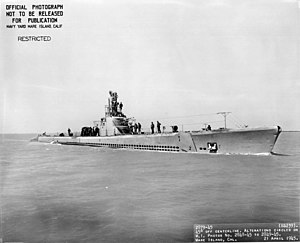USS Whale (SS-239)
 |
|
| History | |
|---|---|
|
|
|
| Builder: | Mare Island Naval Shipyard |
| Laid down: | 28 June 1941 |
| Launched: | 14 March 1942 |
| Sponsored by: | Mrs. A. D. Denny |
| Commissioned: | 1 June 1942 |
| Decommissioned: | 1 June 1946 |
| Struck: | 1 March 1960 |
| Fate: | Sold for scrap, 14 October 1960 |
| General characteristics | |
| Class and type: | Gato-class diesel-electric submarine |
| Displacement: |
|
| Length: | 311 ft 9 in (95.02 m) |
| Beam: | 27 ft 3 in (8.31 m) |
| Draft: | 17 ft (5.2 m) maximum |
| Propulsion: | Template:Fleet-boat-propulsion-early-GM4-GE |
| Speed: |
|
| Range: | 11,000 nmi (20,000 km) surfaced at 10 kn (19 km/h) |
| Endurance: |
|
| Test depth: | 300 ft (90 m) |
| Complement: | 6 officers, 54 enlisted |
| Armament: |
|
USS Whale (SS-239), a Gato-class submarine, was the second ship of the United States Navy to be named for a whale, an extremely large, aquatic mammal that is fishlike in form. The USS Cachalot (SS-170)(Cachalot, another name for a Sperm Whale)commissioned on 1 December 1933 preceded the Whale.
Her keel was laid down on 28 June 1941 by the Mare Island Naval Shipyard of Vallejo, California. She was launched on 14 March 1942 (sponsored by Mrs. A. D. Denny, wife of Captain A. D. Denny, the commanding officer of the shipyard), and commissioned on 1 June 1942, with Lieutenant Commander (Lt. Cmdr.) John B. Azer (Class of 1930) in command.
Dock trials and initial shakedown training commenced on 30 July. The submarine—escorted by destroyer Kilty (DD-137)—departed San Francisco, California, on 4 August and arrived at San Diego, California, two days later. Between 30 July and 9 September, she conducted type training in the San Diego and San Francisco areas.
Whale got underway from San Francisco on 23 September and arrived at Pearl Harbor four days later. The submarine departed Hawaii on 9 October 1942, headed via Midway Island for "Imperial Waters" (the seas surrounding The Empire of Japan), and conducted training dives and battle surface drills en route. She arrived at her assigned patrol area off Kii Suido on 25 October and began to reconnoiter the vicinity which had been designated for a naval minefield. Her original plans had called for the submarine to lay mines 20 nautical miles (37 km) offshore. However, after sighting several outbound freighters about 1 nautical mile (1.9 km) from the coast, executive officer Frederick "Fritz" Harlfinger II (who later commanded Trigger convinced Azer that the mines be planted as close in as possible. Hence Whale's first war patrol was conducted "within spitting distance" of the Japanese beach. Whale was the first American submarine to plant mines in Empire waters. During the war, no one on the American side knew how effective these mines proved to be, but a postwar analysis of Japanese shipping records credited Whale's minefield with sinking five enemy ships.
...
Wikipedia
